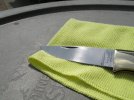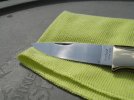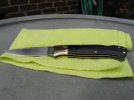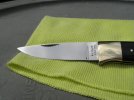- Joined
- Sep 15, 2009
- Messages
- 839
I got a great deal on a Kershaw 1993 that has some minor sharpening scratches on the blade and I'd like to remove them. The problem is the blade can't be removed so I can't just stick it in the vice and sand away. I started sanding a bit yesterday with some 320grit wet/dry paper and I've removed a lot of the scratches but its going very very slowly and I think it would literally take me a month to get back to the origional mirror finish! So does anyone have any tips or tricks? Also how do I avoid rounding the tip? Any help would be greatly appreciated.





